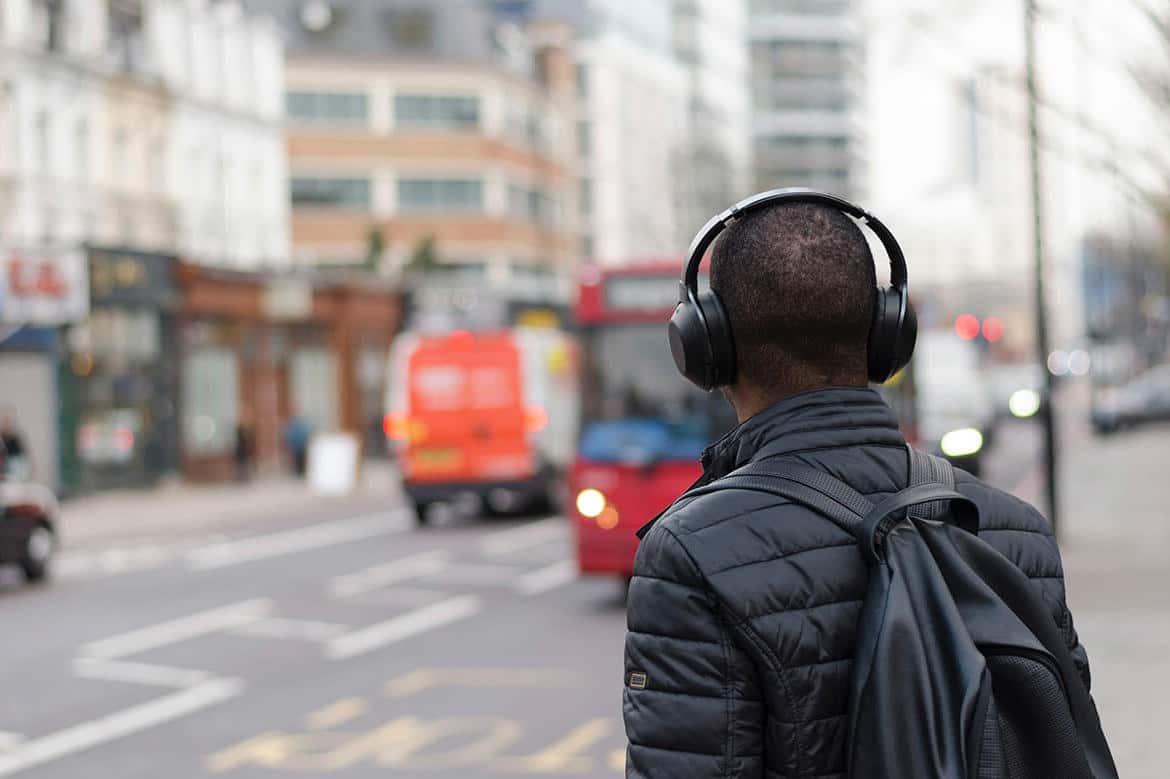Os seres humanos são animais contadores de histórias, parafraseando o romancista Salman Rushdie. Os profissionais criativos conhecem esse impulso inato melhor do que ninguém. É uma verdade universalmente reconhecida - e não apenas pelos escritores. As histórias criam conexões significativas, e nada está atraindo mais o público do que ouvir podcasts.
Os artistas são criadores. É hora de você aprender a fazer um podcast.
A plataforma de conteúdo mais inovadora e extremamente popular do século XXI, na verdade, remonta aos tempos antigos da narração oral de histórias. Os avanços na tecnologia só ajudaram a tornar os podcasts mais fáceis de criar, mais acessíveis e mais viciantes do que nunca. O equipamento de podcast mais essencial de que você precisa? Você precisa de seu cérebro e de uma visão.
Se você quiser se aprofundar, ir mais longe, fazer uma curadoria melhor e dar a si mesmo uma voz (literal), precisa aprender a iniciar um podcast. Muitos fotógrafos, ilustradores e designers bem-sucedidos já estão familiarizados com o envolvimento com o público por meio da narrativa visual; isso começa com o trabalho e o portfólio criativo e depois se estende à mídia social, à narrativa da marca e muito mais.
Agora é hora de fazer com que as pessoas realmente ouçam.
Por que devo criar um podcast?
Aqui estão quatro motivos simples para você começar a fazer podcast.
Poder de permanência
Muito se fala sobre a rapidez com que as coisas acontecem na era digital. As novas tendências chegam hoje e saem amanhã. Não é assim com os podcasts.
Os podcasts, ou "audioblogging", como eram conhecidos antigamente (R.I.P.), existem de alguma forma há quase 40 anos. O podcasting começou a ganhar força no final de 2004 graças ao iPod e ao acesso mais amplo à Internet de banda larga. Em 2005, o termo "podcast" passou a ser A "Palavra do Ano" do New Oxford American Dictionarye o apetite mundial por podcasts vem crescendo constantemente desde então.
É seguro dizer que o podcast está firmemente enraizado no zeitgeist cultural e não mostra sinais de que sairá tão cedo. A longevidade do podcast ultrapassou até mesmo o seu homônimo (iPod + Broadcast = podcast). O dia 30 de setembro é Dia Internacional do PodcastMas quantos amigos seus ainda têm um iPod? Exatamente.
Crescimento estável
As estatísticas atuais de podcasts não mentem. Várias pesquisas atestam o crescimento contínuo dos podcasts; uma delas é Pesquisa de 2017 estima que 42 milhões de americanos com mais de 12 anos de idade ouvem podcasts semanalmente.
A forma como as pessoas ganham dinheiro com podcasting também está mudando para melhor. A receita de anúncios de podcasting mais do que triplicou desde 2015e aumentando para uma estimativa de $220 milhões em 2017. Isso representa um crescimento da ordem de 85%.
E quanto à forma como ouvimos podcasts? A quase onipresença dos dispositivos móveis e o aumento da tecnologia de casa inteligente significam que as pessoas podem ouvir podcasts a qualquer hora e em qualquer lugar. A popularidade do podcast não está nem perto de atingir seu auge.
Conexões mais profundas
O podcasting é uma ótima maneira de criar conteúdo pessoal que elevará sua marca, criará confiança, agregará valor e criará conexões mais profundas e significativas com públicos novos e conhecidos.
Há algo de íntimo em ouvir um podcast que realmente repercute. Em resposta, pesquisas mostram que os ouvintes de podcast são incrivelmente fiéis. De fato, 85% deles você pode ouvir o programa inteiro. É isso aí, atenção curta!
O podcasting é um complemento maravilhoso e pouco utilizado para o conteúdo visual gerado por fotógrafos, designers, ilustradores e outros criadores.
Aumente seu público
Embora se acreditasse que o podcast atendesse apenas a públicos de nicho, sucessos de bilheteria como Em série (o podcast mais rápido para atingir 5 milhões de downloads e transmissões na loja iTunes da Apple) desmascararam esse mito. É mais fácil do que nunca encontrar seu público e transformá-lo em uma base de fãs.
E a melhor parte? Você pode direcionar essa multidão (ou horda!) de volta ao seu site, portfólio, canais sociais e muito mais no final de cada episódio para que o envolvimento continue.
Atenda à conveniência
As pessoas adoram podcasts, em parte porque são muito fáceis de consumir. Em um mundo cada vez mais móvel, os podcasts permitem que você alcance seu público em qualquer lugar - durante o trajeto para o trabalho, preparando o jantar em casa, no trabalho e muito mais.
As estatísticas mostram que a maioria das pessoas está ouvindo podcasts em qualquer lugar; 69% dos americanos ouvem podcasts em um dispositivo móvel. Essa porcentagem está muito acima dos 55% em 2015.
Equívocos comuns sobre podcasts
Vamos esclarecer rapidamente o que você está dizendo, certo?
1. O podcasting é muito caro
FATO: Você pode criar e ouvir podcasts gratuitamente.
Provavelmente você já tem um computador. Você não precisa gastar muito com equipamentos de podcast de alta qualidade. Um software de edição de áudio como o Audacity é gratuito. Há muitas opções gratuitas de hospedagem de podcast. Seus recursos não são infinitos, mas as possibilidades são.
2. Você precisa ser um técnico para fazer um podcast.
FATO: Os recursos de podcast estão disponíveis para qualquer pessoa.
Nossos smartphones são mais inteligentes e nossas vidas são mais fáceis graças aos avanços convenientes da tecnologia. Você pode fazer muita coisa com o apertar de um botão. Hoje, criar um podcast é mais acessível e simples do que nunca. Além disso, há uma tonelada de suporte e orientação disponíveis para você começar (você está aqui, não está?). Continue lendo para que você receba alguns conselhos práticos.
3. Os podcasts precisam ter qualidade de rádio.
FATO: As imperfeições podem aumentar a intimidade dos podcasts.
Você está preocupado com as horas de ensaio e os milhares de dólares em equipamentos de podcast no futuro? Não se preocupe. O público valoriza mais a autenticidade do que o valor da produção. Deixar sua personalidade brilhar, com suas peculiaridades e tudo mais, sempre supera a "voz de rádio".
4. Você não tem nada de novo a dizer em um podcast.
FATO: Os tópicos de podcast não precisam reinventar a roda.
Com mais de 21,2 milhões (e aumentando) de horas de audição diáriaSe você não tem conhecimento especializado, há inúmeras oportunidades de capitalizar seu conhecimento especializado. Uma rápida olhada no vasto mar de categorias e subcategorias do iTunes deve inspirar você.
Se você cobrir um nicho novo ou mal atendido, talvez possa se posicionar como um inovador do setor. Mas, se não for o caso, tudo bem também.
Lembre-se de que sua arma secreta é que ninguém vê o mundo como você. Existem muitos podcasts sobre arte, por exemplo, mas você não tem a mesma visão. Broad CityAbbi Jacobson, podcast de Abbi Jacobson sobre arte Uma peça de trabalho transmite com sucesso seu ponto de vista único.
5. Você não tem tempo para fazer podcasts.
FATO: Sempre há tempo para fazer um podcast.
Não há desculpas! Lembre-se de seus tempos de escola de arte e confira Revista Rookie contribuinte O guia de Kendra Yee para uma produtividade sem horários quando você tem muito o que fazer.
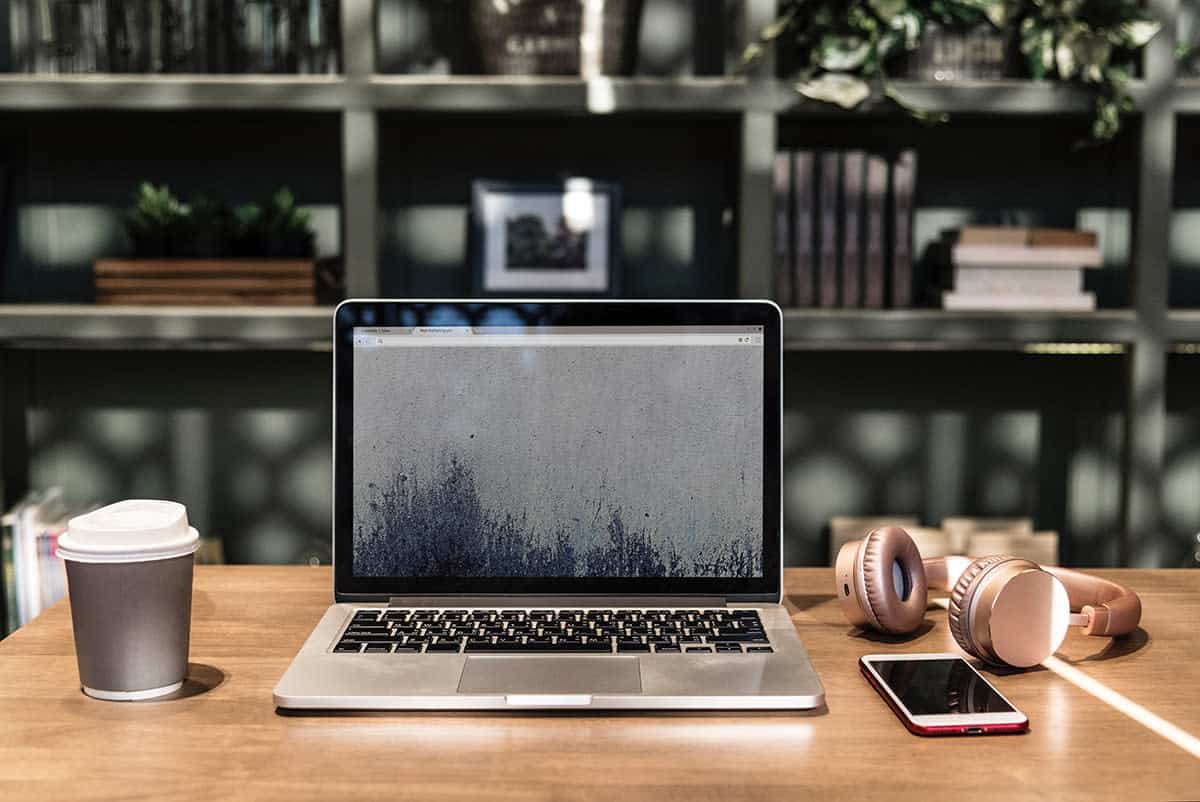
1: Como funciona o podcasting
Independentemente de você estar familiarizado com os conceitos básicos de podcasting ou de estar explorando um novo território, é importante ter uma boa noção de como o podcasting funciona.
Aqui está o que você precisa para criar seu próprio podcast:
- Compre um microfone para podcasting
- Pesquisar e adquirir equipamentos adicionais de podcast
- Conecte o microfone ao computador
- Instalar software de gravação e edição de áudio
- Faça uma gravação de podcast e salve o arquivo de áudio
- Carregue o arquivo em um site de hospedagem de podcast
- Envie-o para um diretório de podcasts como iTunes
Veja como isso funcionará para seus ouvintes:
Site de podcasting ou leitor de feeds
Os ouvintes podem transmitir ou fazer download do podcast diretamente do site onde o podcast está hospedado (SoundCloud, Simpelcast e Buzzsprout são algumas opções populares).
iTunes, Apple Podcasts e outros players
Uma opção totalmente compatível com dispositivos móveis, os ouvintes carregam o Feed RSS em um reprodutor de podcast (como o Apple Podcasts) para reproduzir o feed em seus smartphones e tablets.
Você está se perguntando como carregar um podcast no iTunes? Cumpra os requisitos. Você precisa de arte, feed e conteúdo especificações ao carregar seu podcast no iTunes, mas vale a pena o esforço adicional. De acordo com o 9to5MacEm comparação com o ano anterior, 85% da audição de podcasts móveis ocorre em um iPhone por meio do aplicativo Podcasts nativo.
O que é ainda melhor é que agora é possível medir o desempenho do seu podcast e fazer as alterações necessárias usando o Apple Podcasts. A Apple finalmente ativou seu podcast recurso de análiseque dá aos criadores de podcasts acesso a informações agregadas sobre como as pessoas estão interagindo com seu conteúdo.

2: Visualização
Antes de começar a criar seu próprio podcast, você precisa de um plano. Para criar um conceito sólido, você deve incluir os seguintes elementos:
- Tópico do podcast
- Nome do podcast
- Podcast Format
- Duração do podcast
Tópico do podcast
Tentar criar um tópico ou tema para um podcast pode parecer muito difícil. Faça a você mesmo as seguintes perguntas para restringir as coisas.
"Qual é a minha paixão?"
A paixão é um ingrediente essencial para qualquer podcast. Você pode deixar as pessoas entusiasmadas com literalmente qualquer coisa se tiver paixão suficiente pelo assunto. É provável também que você se divirta mais, seja mais consistente e se envolva com seu público em um nível mais humano.
"Qual é o meu nicho?"
Pense nas suas áreas de especialização ou no conhecimento especializado que você tem para compartilhar. Você pode se posicionar como um pioneiro e capitalizar um nicho mal atendido em seu setor?
As pessoas adoram aprender coisas novas, especialmente se você for um especialista e apaixonado pelo assunto em questão.
"Meu tópico pode ter um apelo mais amplo?"
Certifique-se de que o tópico do podcast não seja tão restrito a ponto de ser acessível apenas a um público muito limitado. Tente evitar a alienação dos ouvintes, limitando o uso de jargões e fornecendo contexto suficiente.
Outra maneira de tornar seu podcast mais acessível é escolher um tópico que permita uma variedade de conteúdo que unificará diferentes públicos.
Confira esta lista de podcasts para melhorar o pensamento criativo para que você tenha uma ideia de como fotógrafos, ilustradores, designers e artistas plásticos criaram podcasts inspiradores não apenas para colegas artistas e apreciadores de arte, mas para qualquer pessoa que goste de adicionar um pouco de criatividade ao seu dia a dia.
"O tópico do meu podcast é suficientemente interessante?"
Se você quiser criar conteúdo em uma programação consistente de podcasting (acredite, você quer), certifique-se de que o tópico possa se sustentar além de um ou dois episódios. Você não deve esticar demais o tópico do podcast, pois isso será perceptível.
Tente mapear o que você abordará nos primeiros 10 episódios. Se parecer que você está se agarrando a palhas, não se comprometa com o tópico.
Como dar um nome ao seu podcast
O que há em um nome? Depende. Reserve algum tempo para fazer um brainstorming de uma lista de nomes de podcasts, levando em consideração suas preferências pessoais, voz e marca. Você tem alguma palavra popular ou frase atraente relacionada ao seu tema?
Ao escolher um nome, você também deve verificar se já não existe um podcast com um título semelhante ou, pior ainda, exatamente igual ao seu. Faça a devida diligência e você evitará muitos problemas no futuro. E se você estiver realmente sem ideias, existem até ferramentas que ajudam a despertar a inspiração ou a gerar nomes para você.
Podcast Format
A estrutura é importante e há muitas opções quando se trata de formato de podcast. A consistência é extremamente importante para que seu público saiba o que esperar de você, portanto, escolha sabiamente. Aqui estão alguns formatos populares de podcast, juntamente com alguns prós e contras para ajudar você a decidir.
Estilo de entrevista
Um podcast no estilo de entrevista é um formato com o qual a maioria das pessoas está familiarizada. Normalmente, as entrevistas apresentam o mesmo apresentador (ou apresentadores) em cada episódio e apresentam aos ouvintes uma série de pessoas interessantes relacionadas ao tópico do podcast.
Prós:
- É necessário um mínimo de edição
- Geralmente sem roteiro, com fluxo livre e autêntico
Contras:
- Requer muito tempo de espera para garantir os hóspedes
- Conflitos de agendamento com convidados podem ser difíceis de resolver
- Super saturação de podcasts no estilo de entrevista; você precisará de um toque único
Confira WorkLife com Adam Grant e Ar fresco da NPR Por exemplo.
Painel e hospedagem múltipla
Um podcast com mais de um apresentador ou um painel de convidados pode ser extremamente animado e divertido. Esse formato permite que o público se sinta como se estivesse ouvindo uma conversa incrível (sem culpa!).
Prós:
- Menos pressão, pois a responsabilidade de gerar conversas interessantes é distribuída
- Personalidades diferentes significam mais variedade
Contras:
- Requer mais equipamentos, pois todos devem ter um microfone
- É necessário um pouco mais de conhecimento técnico para gravar com sucesso
- Coordenar várias programações pode ser uma tarefa difícil
Confira A mãe e o pai de Slate estão brigando e Esta semana em fotos Por exemplo.
Solo
Os monólogos ou os solos-casts são voltados para o criador. O apresentador geralmente faz um monólogo diferente ou conta uma história a cada episódio. Os podcasts solo são apresentados em uma variedade de tons e estilos, desde humorísticos até educativos.
Prós:
- Logisticamente fácil e sem restrições de agendamento
- Fácil de criar uma conexão íntima e individual com um público
- Possibilidade de trazer um convidado ocasional para misturar as coisas
Contras:
- Você é o único responsável pela geração de todo o conteúdo
- Depende muito dos recursos do host
- Possibilidade de você se sentir monótono ou excessivamente indulgente
Confira Lore e História do hardcore de Dan Carlin Por exemplo.
Narrativa de não ficção
Os podcasts de histórias narrativas de não-ficção contam histórias verdadeiras do mundo ao nosso redor. O objetivo é despertar a curiosidade do ouvinte. Eles podem variar de comentários sobre eventos atuais a investigações aprofundadas e altamente pesquisadas.
Prós:
- É fácil prender o público se ele gostar do seu estilo de contar histórias e ficar intrigado com o assunto
- Muita liberdade criativa com edição e produção
Contras:
- A pesquisa pode consumir muito tempo
- Como esse formato geralmente envolve alguma combinação de clipes de áudio de arquivo, entrevistas, narração e muito mais, ele exige muita edição e pós-produção.
Confira O detetive de arte para um exemplo.
Há dezenas de outros formatos que você pode pesquisar. Ou por que você não cria seu próprio híbrido de alguns dos formatos mencionados acima?
Duração do podcast
É importante que você seja realista e mantenha a consistência quando se trata da duração do podcast. Você não quer que um episódio dure 15 minutos e o próximo dure 45 minutos.
Respeite o tempo do seu público e leve em consideração que ele pode estar ouvindo o podcast durante o trajeto diário ou entre atividades. Em geral, 20 minutos é a duração ideal para um podcast.
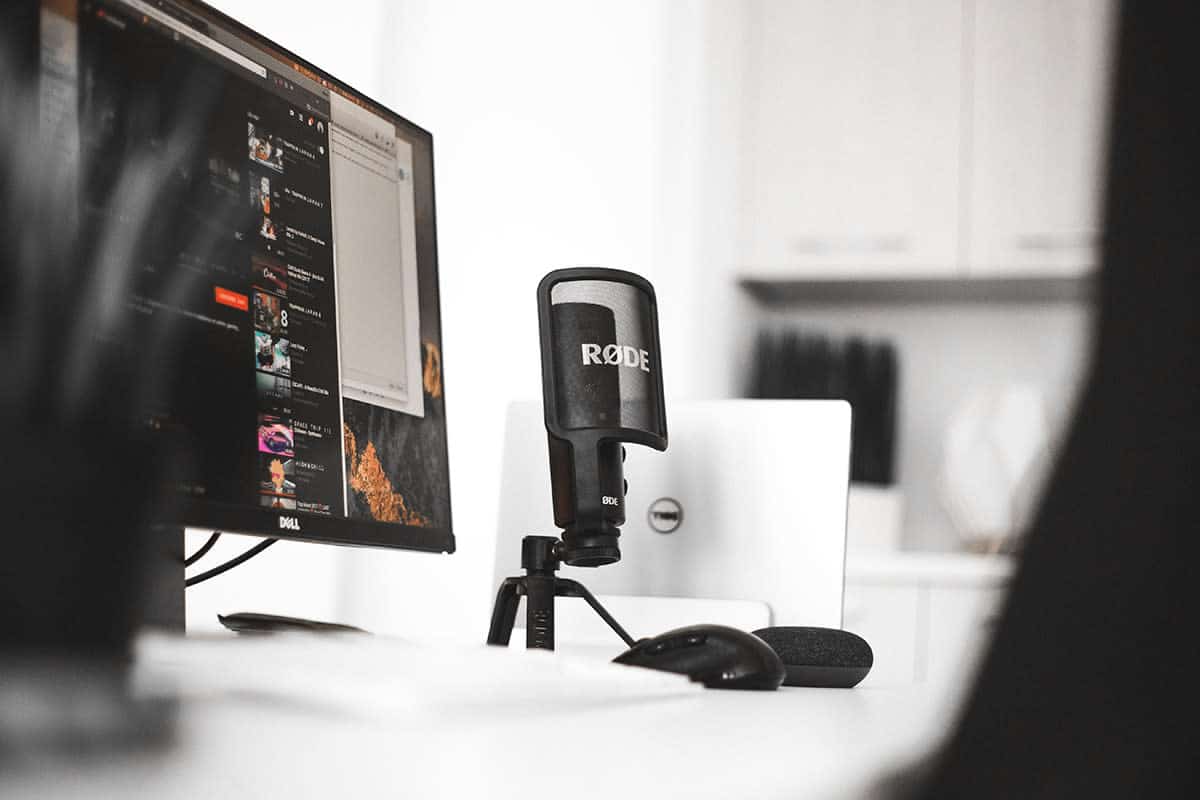
3: Equipamento e software de podcast
Qual é o melhor equipamento para você começar um podcast? Qual software de podcast você deve usar? Isso depende dos requisitos do seu podcast e de suas necessidades individuais. A boa notícia é que o equipamento e a configuração do podcast não precisam ser complicados nem caros.
Equipamento essencial para podcasts
Microfone(s)
Um microfone externo decente é essencial para qualquer podcast. Os microfones USB são as opções mais econômicas, pois você não precisa comprar uma interface de áudio para alimentar o microfone. Basta conectar o microfone à porta USB do computador e você estará pronto para começar. Aqui estão quatro opções que se ajustam a diferentes orçamentos.
- Smartphone (gratuito, mais ou menos): Sim, tecnicamente você pode gravar seu podcast no iPhone ou no dispositivo Android que você já possui. Seu smartphone tem um microfone para gravar áudio, mas a qualidade do som provavelmente será inferior.
No entanto, há aplicativos disponíveis para iOS e Android que podem ajudar a elevar a qualidade do áudio do seu podcast, como Spreaker ou Gravador iRig. A maioria dos aplicativos é muito econômica ou oferece funcionalidades básicas gratuitamente.
Samson Go Mic ($39,99 USD): Tão fácil de levar em viagens quanto de caber no seu orçamento, o Samson Go Mic é o microfone econômico perfeito para podcasting. Com captação cardioide (direcional) e omnidirecional, você pode prender esse microfone ao computador ou colocá-lo sobre a mesa. Compatível com PC e sem necessidade de drivers ou instalação.
MXL990 ($74.95 USD): Com um visual vintage elegante, o microfone condensador MXL990 tem excelente qualidade de som profissional a um preço razoável. A única desvantagem? O MXL990 requer um cabo XLR, portanto você precisará de um conversor XLR para USB.
Microfone Blue Yeti USB ($126 USD): Um best-seller da Amazon, o elegante microfone retrô Blue Yeti oferece excelente qualidade de áudio com padrões direcionais e omnidirecionais (ótimo para entrevistas e painéis). Ele também tem um plugue para fones de ouvido e possui saída de áudio integrada.
Software de gravação e edição de áudio
Um software de gravação e edição de áudio de nível profissional pode ser um grande investimento. Programas como o Reason, o Adobe Audition ou o Protools podem ser muito complicados e custar a você centenas de dólares. Também é um exagero completo se você for um iniciante em podcast. Em vez disso, experimente estes programas.
Audacity (gratuito)
O Audacity é o Santo Graal do podcasting - e é gratuito. De código aberto, simples de usar e compatível com Mac, Windows e Linux, o Audacity oferecerá a você o melhor valor e o ajudará a começar imediatamente.
GarageBand (Gratuito, somente para Mac)
O GarageBand é outra opção útil para gravar e editar seu podcast. Embora venha gratuitamente em todos os computadores Mac e seja extremamente fácil de usar, ele pode ser limitado, pois não é compatível com o Windows.
Ceifador ($60 USD)
Totalmente equipado com uma ampla gama de ferramentas de edição de áudio, a funcionalidade do Reaper está no mesmo nível de um padrão do setor, como o Protools, por apenas uma fração do preço. Você pode testá-lo por 60 dias antes de comprar. É uma opção especialmente valiosa se a música for um elemento importante do seu podcast.
Equipamento de bônus
Software de gravação de chamadas
Se estiver planejando entrevistar convidados de fora da cidade ou se o espaço de configuração do seu podcast não puder acomodar várias pessoas, você pode procurar um software para gravar suas chamadas do Skype ou do Google Hangout.
Software como UberConferência e Nota de chamada são gratuitos (ou têm opções gratuitas) e são fáceis de usar.
Filtros pop
Os filtros pop (o pequeno acessório de malha redonda na frente do microfone) são uma maneira barata de gravar um áudio mais nítido e claro. Os filtros pop ajudam a silenciar quaisquer plosivas ou ruídos de clique quando você fala muito perto do microfone.
Você não tem espaço no seu orçamento? Você pode Crie seus próprios filtros pop gratuitamente.
Fones de ouvido de qualidade
Fones de ouvido confortáveis com o mínimo de vazamento de som podem ser um divisor de águas no podcasting. É especialmente importante usar fones de ouvido se você estiver entrevistando um convidado para que a voz dele não passe pelos alto-falantes. Ninguém gosta de um eco irritante.
Gravador digital portátil
Planeje-se para o inesperado e grave seu áudio em um gravador digital portátil, como o Gravador portátil Zoom H1. Se o seu computador travar, for danificado ou você sofrer uma queda de energia no meio da sessão, você sempre terá um backup se usar um dispositivo de gravação externo. Isso também é útil para você viajar! Além disso, não se esqueça de comprar alguns cartões SD para salvar o áudio do seu gravador, pois eles geralmente não têm memória interna!
Braço da lança
A compra de um braço de boom ajudará a manter suas mãos livres e permitirá que você posicione o microfone em um nível que lhe permita falar e gravar o podcast confortavelmente. Ele também ajudará a reduzir qualquer tipo de trepidação no microfone, garantindo que você obtenha a mais alta qualidade de áudio possível.
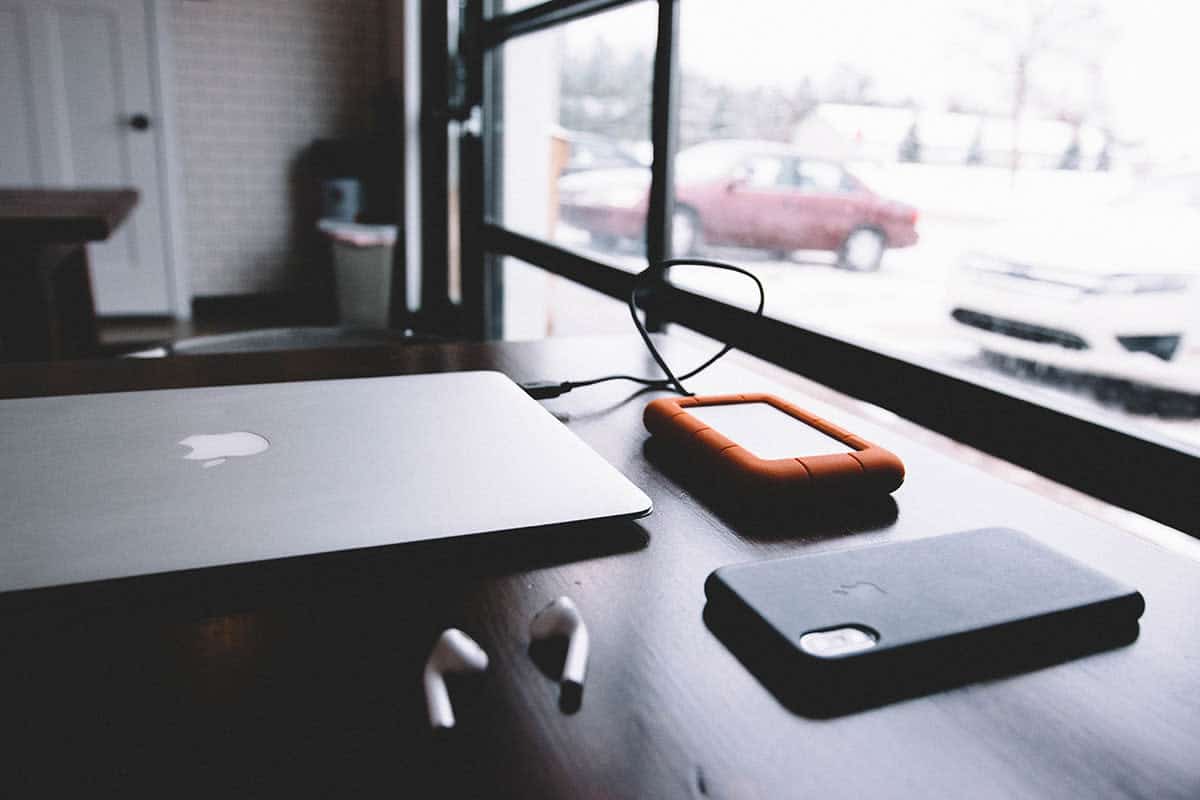
4: Execução
Você já tem seu plano, seu equipamento de podcast, agora é hora de começar a gravar e hospedar seu podcast!
Como gravar um podcast: O básico
- Organize a configuração do seu podcast em uma área tranquila e sem interrupções
- Conecte seu microfone USB para podcast
- Inicie seu software de gravação de áudio e verifique se o microfone é o dispositivo de entrada padrão
- Clique em "record" (gravar) e seja o episódio do seu podcast
- Continue mesmo que você cometa erros; é para isso que serve o software de edição
- Salve seu podcast assim que você terminar [MP3s são os formatos mais amplamente suportados e mais fáceis de usar]. altamente recomendado)
- Os MP3s devem ser salvos em uma taxa de bits fixa; a faixa de taxa de bits para podcasts é normalmente 96 a 128 kbps (limite inferior para podcasts que apresentam principalmente conversas, limite superior para podcasts com muita música ou efeitos)
Dicas para você criar seu primeiro episódio de podcast
- Apresente-se ao seu público; forneça algum contexto para a jornada que você tem pela frente
- Ouça o primeiro episódio de podcasts que você gosta ou que são semelhantes aos seus
- Não se deixe abater pelo nervosismo, pois isso ficará mais fácil à medida que você for avançando
- Tenha água por perto para se manter hidratado
- Seja você mesmo, deixe sua personalidade brilhar e não leia um roteiro
- Aceite seus erros como experiências de aprendizado
- Não se apresse; reserve um segundo para se reagrupar ou se recompor, pois qualquer silêncio pode ser editado mais tarde
Como editar podcasts
Um podcast é mais do que apenas alguém falando. Mesmo coisas aparentemente sutis, como áudio nítido, níveis de volume consistentes, ausência de intervalos ou pausas longas e ruídos de fundo mínimos, podem elevar o seu podcast.
Aspectos mais atraentes, como efeitos sonoros ou música de introdução imediatamente reconhecível, podem ajudar a diferenciar o seu podcast dos demais.
Toda essa mágica acontece em seu software de edição de áudio. Já mencionamos nossas sugestões acima, portanto, confira estes incríveis tutoriais do YouTube sobre Como editar podcasts no Audacity, Como editar podcasts no GarageBande Como editar podcasts no Reaper.
Metadados de podcast e tags ID3
Em poucas palavras, os metadados são informações sobre o podcast. Eles tornam o podcast pesquisável e a arte da capa acessível, especialmente se os ouvintes estiverem baixando episódios para reproduzi-los em diferentes dispositivos.
Depois de salvar o podcast como MP3, o arquivo de áudio conterá dados de faixa incorporados, como o título do episódio, o artista e muito mais. Você deve otimizar os metadados incorporados adicionar tags em um formato ID3.
Experimente editores ID3 gratuitos, como EasyTAG para Windows, Editor de metadados do DataONEou Editor ID3 ($15 USD) para Mac.
Editando extras: Adicionando música tema a podcasts
Você quer criar um podcast de alto nível? Tudo está nos detalhes. Adicionar música a cada episódio de seu podcast é uma boa marca. Além de tornar seu podcast memorável e facilmente identificável, ele define o tom do que está por vir.
Como você adiciona música tema ao seu podcast?
- Peça a um amigo que tenha alguma habilidade musical ou de gravação para criar um tema personalizado (se você não tiver a habilidade de fazer isso sozinho, é claro)
- Contrate um freelancer para criar a música tema do seu podcast em um site como Fiverr
- Navegue pelo Arquivo de músicas gratuitas para faixas para download que podem ser usadas gratuitamente por qualquer pessoa (não se esqueça de dar crédito ao criador na descrição do podcast!)
Edição de extras: Adicionando introduções e encerramentos a podcasts
Para que seu podcast comece com o pé direito, adicione introduções e encerramentos a cada episódio. Uma introdução não precisa ser nada mais do que uma breve narração (música opcional) que apresente você e seu podcast pelo nome.
Você também pode incluir o número do episódio, uma visão geral do tópico ou do tema e um gancho intrigante que leve o público a continuar ouvindo. O Buzzsprout analisa uma variedade de formatos de introdução de podcast e fornece uma tonelada de informações úteis para você começar.
Edição de extras: Adicionando capítulos a podcasts
A inclusão de capítulos de podcast coloca seus ouvintes no lugar do motorista e permite que eles naveguem pelos episódios de forma mais conveniente. Adicionar capítulos ao seu podcast pode ser especialmente útil se o podcast for mais longo (mais de 30 minutos), se você cobrir uma variedade de tópicos ou se apresentar um convidado diferente em cada segmento.
O ouvinte pode pular seções do podcast para atender às suas necessidades. Recomenda-se o uso de um software de adição de capítulos de podcast para facilitar esse processo para você. Experimente o Capítulos de podcast ($19.99) se você estiver usando um Mac (confira este prático aplicativo Passo a passo dos capítulos do podcast.
Como hospedar seu podcast
Depois de gravar, salvar, marcar e exportar, aqui estão alguns dos melhores lugares para você hospedar seu podcast. A hospedagem permite que você faça com que seu podcast apareça em diretórios e aplicativos de podcast. Pense em quantos podcasts você publicará mensalmente ao considerar as necessidades de largura de banda.
Hospede seu podcast no SoundCloud
- Hospedagem gratuita de podcast com opções escalonáveis
- Permite a distribuição via feed RSS
- Fácil de compartilhar em mídias sociais e sites pessoais
- Um dos sites de hospedagem mais antigos e confiáveis
- Preço baixo ($5 por mês)
- Largura de banda ilimitada
Hospede seu podcast no Podomatic
- Fácil de usar para iniciantes
- Hospedagem gratuita com largura de banda moderada
- Atualização paga disponível para aumentar a largura de banda
Outras opções de hospedagem de podcast
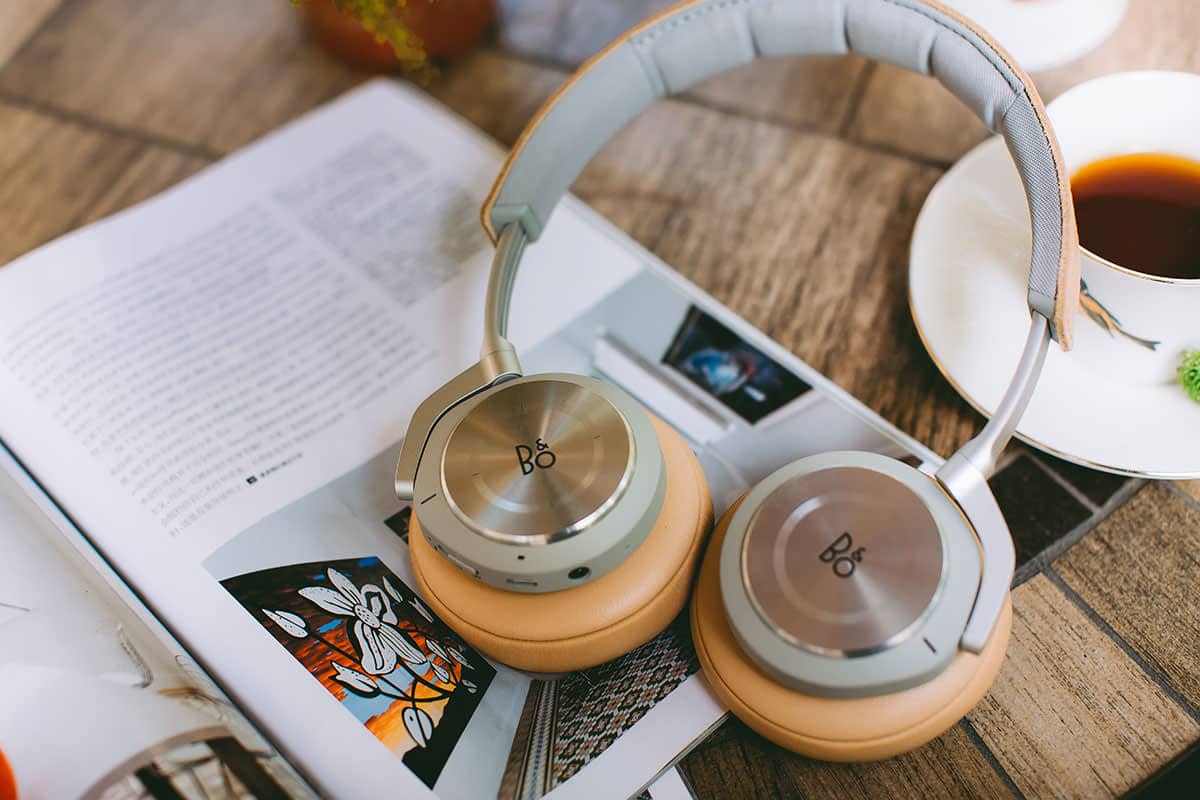
5: Crescimento e promoção de seu podcast
Parabéns! Agora você sabe como iniciar um podcast! Agora é hora de lançar seu navio no vasto oceano da Internet e distribuir seu podcast. Aqui estão algumas dicas para você criar ondas com seu podcast.
Gerar buzz
Use seus canais sociais e redes profissionais para começar a criar impulso antes de você lançar seu podcast. Crie uma página de destino em seu site, reúna uma lista de e-mails, altere a descrição em suas biografias nas mídias sociais, comece a publicar conteúdo teaser e arte da capa e use hashtags para iniciar a conversa.
É hora de aproveitar todas as suas faculdades criativas (e o apoio dos amigos)!
Tenha um podcast do calibre de "Novo e digno de nota" no iTunes
Agora você sabe como colocar um podcast no iTunes. Mas você conhece a lista "New and Noteworthy" do iTunes? Ela costumava ser uma ótima maneira de colocar seu podcast na frente de novos públicos por oito semanas. Mas há rumores de que, a partir de março de 2018, o iTunes não atualiza mais a lista "New and Noteworthy". Lista de novos e dignos de nota.
Independentemente disso, você deve ter o mesmo plano de jogo para o lançamento do seu podcast - com lista ou sem lista. Além de criar um burburinho, lance mais de um episódio, criar arte de capa de podcast de alta qualidadee aproveite suas conexões para obter avaliações de podcast.
Além disso, confira este incrível guia do YouTube sobre como obter seu podcast na lista New & Noteworthy no iTunes (por precaução). É um investimento de apenas dois minutos.
Recompensar o engajamento
Você quer que o seu público ouça, comente e compartilhe amplamente o seu podcast. Incentive a participação e demonstre seu apreço criando recompensas para os ouvintes que participarem. A recompensa pode ser uma mensagem na mídia social, um pequeno brinde ou algo relacionado ao tópico sobre o qual você está fazendo o podcast.
Para direcionar os negócios para o seu site e chamar a atenção para suas habilidades e serviços, você pode considerar a possibilidade de oferecer um tutorial de design gratuito, uma sessão de fotografia de retrato ou uma ilustração personalizada como recompensa para alguns de seus ouvintes fiéis e engajados.
Agora que você sabe o que precisa fazer para iniciar um podcast, é hora de sair e gravar! Marque @useformat em Instagram ou Twitter para nos manter atualizados - mal podemos esperar para sintonizar!
